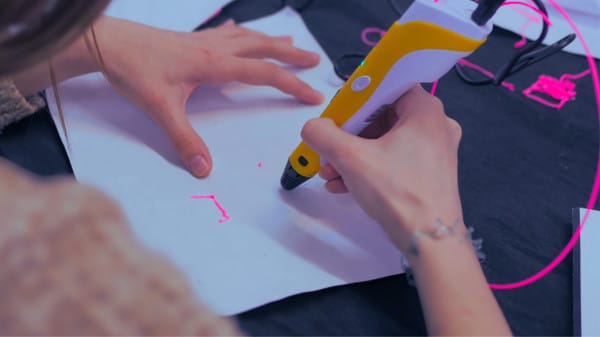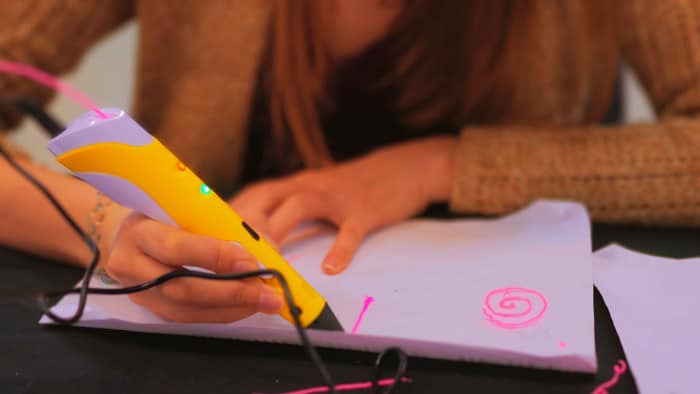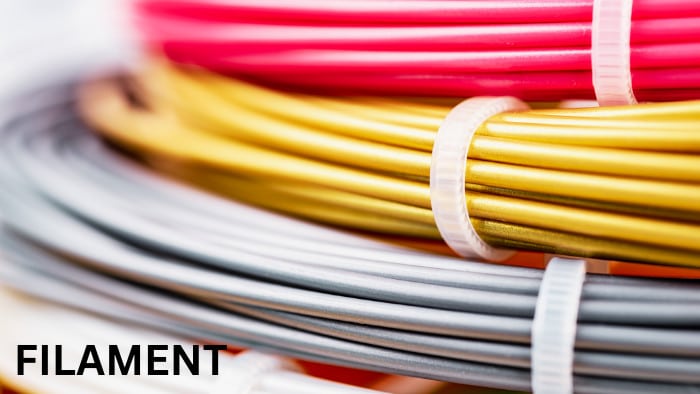3D printing technology has revolutionized the manufacturing industry, making it easy to create complex and customized objects. 3D printing pens are one of the latest innovations in this field, rapidly gaining popularity among artists, designers, and DIY enthusiasts. This article will explore what 3D printing pens are and how they can be used.
A 3D printing pen is a handheld device that lets you create three-dimensional objects by drawing them in the air. It works by extruding heated plastic through a nozzle, which quickly cools and solidifies, allowing you to build layers and shapes. 3D printing pens are easy to use and require no special training or software. They come with various filaments, including ABS, PLA, and PETG, which are non-toxic and eco-friendly.
There are many use cases for the 3D printing pen, which primarily allows you to create basic 3D printed objects using the pen as your only tool and not requiring software applications like Blender or actual 3D printers to create these objects.
The Different Use Cases For The 3D Printing Pen
As we mentioned, there are different reasons why we would look to use a 3D printing pen in place of a traditional 3D printer, such as the following…
- Art and Design
3D printing pens have opened up new possibilities for artists and designers, enabling them to create intricate sculptures and objects with great detail. Drawing in three dimensions means that artists can add depth and texture to their work, creating a unique and eye-catching style. Many artists use 3D printing pens to make jewelry, sculptures, and other decorative items.
- Education
3D printing pens are an excellent tool for educators who want to introduce their students to 3D printing. They are easy to use and help students understand complex concepts such as geometry and spatial reasoning. They can also teach children about engineering and design, allowing them to create objects and models.
- Prototyping
3D printing pens are an ideal tool for prototyping new products and ideas. They allow designers to quickly create and modify their designs, making it easy to iterate and refine their ideas. Because 3D printing pens are portable and easy to use, they are a popular choice for engineers and designers who need to create prototypes on the go quickly.
- DIY Projects
3D printing pens are an excellent tool for DIY enthusiasts who want to create customized objects. They can be used to create everything from phone cases to figurines and toys. With a 3D printing pen, you can bring your ideas to life and create objects that are uniquely yours.
- Repair and Maintenance
3D printing pens can be used to repair and maintain a variety of objects. They can be used to fix broken toys, create replacement parts for household appliances, and even repair car parts. With a 3D printing pen, you can save money and time by creating replacement parts instead of buying them.

3D printing pens are versatile and innovative tools with numerous applications in art, education, engineering, and DIY. Their ease of use and portability have opened up new possibilities for creators and designers, allowing them to bring their ideas to life in three dimensions. Whether you are an artist, engineer, or DIY enthusiast, a 3D printing pen is a valuable tool to help you create, repair, and innovate.
Using A 3D Printable Pen
3D printing pens are versatile tool that allows you to create three-dimensional objects by drawing them in the air. They work by extruding heated plastic through a nozzle, which quickly cools and solidifies, allowing you to build layers and shapes. Here’s how you can use a 3D printing pen:
- Choose your filament
Before using a 3D printing pen, you must choose a suitable filament. Various filaments are available, including ABS, PLA, and PETG. Each filament has its unique properties, so it’s essential to choose the one that best suits your needs.
- Heat the pen
Most 3D printing pens have a heating element that heats the plastic filament to the required temperature. You need to wait for the pen to heat up before using it. The temperature will depend on the type of filament you are using, so make sure to check the manufacturer’s instructions.

- Start drawing
Once the pen is heated up, you can start drawing. You need to hold the pen like a regular pen or pencil and move it slowly, allowing the plastic to come out of the nozzle. You can create different shapes and designs by moving the pen in different directions.
- Build up layers
To create a three-dimensional object, you need to build up layers of plastic. You can draw one layer at a time and allow it to cool before adding the next layer. This will create a solid object that you can hold in your hand.
- Add finishing touches
Once you have created your object, you can add finishing touches such as sanding or painting. This will give your thing a professional look and make it more durable.
3D printing pens are a fun and easy way to create three-dimensional objects. They are versatile and can be used for various applications, including art, education, prototyping, DIY projects, and repair and maintenance. Following the simple steps above, you can create your three-dimensional objects and bring your ideas to life.
How Much Does A 3D Printing Pen Cost?
The cost of 3D printing pens can vary depending on the brand, features, and quality of the pen. Generally, you can find a basic 3D printing pen for around $20 to $30, while more advanced models cost up to $100 or more.
Basic 3D printing pens typically have simple features such as temperature control, filament loading, and speed control. They may also come with a limited number of filaments and accessories.
More advanced 3D printing pens may have additional features such as an OLED display, automatic filament loading, and adjustable nozzle size. They may also include a broader range of filaments, accessories, and replacement parts.
It’s essential to research before buying a 3D printing pen to ensure you’re getting the best value for your money. Look for reviews and ratings from other users, compare features and prices across different brands, and consider your needs and budget before purchasing.
Comparing Pens Based On Price And Which Pen Is Best For You
Generally speaking, though, we have tried the following 3D printing pens of various prices, and the conclusion we came to was that, in this case, spending a little bit extra on the pen resulted in better results for the actual structures that the pen created. Here are a few that we tested.
- MYNT3D Basic Pen
Price: £46.00
Verdict: This was the cheapest pen that we tried, and while we were able to create basic structures, difficulty with the pen temperature meant that we had to repeat the process numerous times to get the right result, which in turn used up more filament than what was perhaps necessary. The pen itself is also a slightly cumbersome pen to hold.
It has everything needed to do what you need it to do but needs a bit of getting used to when you initially use it.
2. 3Doodler Create+
Price: £80.00
Verdict: Regarding price vs performance, the 3Doodler create + would be our preferred choice. It was the one we were most comfortable holding for extended periods, which is essential because you can’t rush the process, regardless of the pen you use.
Blockage tools are included with the pen in case you have any issues with the filament, a common problem with using 3D pens. There is also a window where you can see inside the chamber, allowing you to determine if there is an issue more efficiently.
The temperature was easy to get right. We spent little time getting up to speed using the pen.
3. 3Doodler Pro+
Price: £180.00
Verdict: We were so impressed using the create+ that we decided to stick with 3Doodler for the more expensive pro pen. For the added price, you get access to more useful features and, perhaps most importantly, improved compatibility with more filament types, including metal filaments like copper.
This was the all round best of the pens we tested, as it should be. However the value is a bit steep, especially since there are few reasons why you would use a pen over a printer for commercial applications. A 3D printing pen is best used for concepts of designs for us, but is a little bit more geared to hobbyists than professionals, so the price is a bit too steep for our tastes compared to the Create+.
Choosing The Correct Filament For Your Pen
When choosing the correct filament for your 3D printing pen, there are several factors you should consider.
Filament diameter: The diameter of your 3D printing pen’s nozzle will determine your chosen filament diameter. Check the manufacturer’s instructions or specifications to find out the appropriate diameter for your pen.
Type: There are several types of filaments available for 3D printing pens, including PLA, ABS, PETG, Nylon, and others. Each filament type has its own properties and recommended printing temperature. Choose the filament type that best fits your needs.

Color: Choose a filament color that suits your design or project.
Quality: Make sure to choose high-quality filament to avoid problems such as clogging or uneven extrusion. Check reviews or ratings of the filament you’re considering before purchasing.
Price: Different filaments have different prices, so consider your budget before making a choice.
Storage: Proper storage of the filament can help maintain its quality and performance. Choose a filament that comes with a resealable bag or container to keep it dry and free from dust.
Should An Artist Invest In A 3D Printing Pen?
3D printing technology has revolutionized the way artists and designers create their work. With the development of 3D printing pens, artists can now take their creativity to the next level by bringing their designs to life in three dimensions. But is investing in a 3D printing pen worth it for an artist? Let’s take a closer look.
First, it’s essential to understand what a 3D printing pen is and how it works. A 3D printing pen is a handheld device that allows you to create 3D objects by extruding plastic filament through a heated nozzle.
The pen works similarly to a glue gun, but it uses plastic filament to complete your design instead of glue. The filament is melted and solidifies as it cools, allowing you to create intricate designs and structures.
So, should an artist invest in a 3D printing pen? The answer depends on several factors, including the artist’s work style and the projects they want to create.
One of the main advantages of a 3D printing pen is its versatility. It allows artists to create complex designs and structures that would be difficult or impossible to achieve using traditional methods. The pen can create everything from jewelry and sculptures to functional objects like phone cases and pen holders.
Another advantage of a 3D printing pen is its speed. Creating a design with a traditional 3D printer can take hours or even days. However, with a 3D printing pen, artists can create their designs in real-time, making it an excellent tool for sketching and prototyping.
However, there are also some downsides to investing in a 3D printing pen. One of the most significant drawbacks is the learning curve.
Using a 3D printing pen can be tricky, especially for those unfamiliar with the technology. It can take some time and practice to master the technique and create high-quality designs.
Another disadvantage of a 3D printing pen is the cost. While the pens are relatively inexpensive, the cost of the plastic filament can add up over time, especially for those who use the pen frequently.
Ultimately, whether or not an artist should invest in a 3D printing pen depends on their individual needs and goals. If an artist wants to explore new mediums and techniques or create complex designs, a 3D printing pen may be a worthwhile investment.
However, if an artist is happy with traditional methods and doesn’t need 3D printing, a 3D printing pen may not be worth the expense.
In conclusion, a 3D printing pen can be a valuable tool for artists looking to push their creative boundaries and explore new mediums.
While there are some downsides to consider, the versatility and speed of a 3D printing pen make it an excellent option for those looking to create intricate designs and structures in real time. Ultimately, investing in a 3D printing pen should be based on an individual artist’s needs and goals.
Thanks For Reading
We appreciate you taking the time to read through the article. We hope you found the information you were looking for. If you are interested in learning more about the Blender software, you can check out a few of the articles we have listed below.